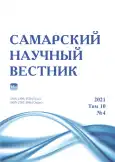Concert life of the South Ural province in the post-war decade
- Authors: Trifonova M.S.1, Godovova E.V.1
-
Affiliations:
- Orenburg State Pedagogical University
- Issue: Vol 10, No 4 (2021)
- Pages: 197-200
- Section: Historical Sciences and Archaeology
- URL: https://journals.rcsi.science/2309-4370/article/view/104918
- DOI: https://doi.org/10.17816/snv2021104210
- ID: 104918
Cite item
Full Text
Abstract
The paper studies the main patterns of productive life development in the South Ural province. The geography of the paper is limited to the rural areas of the Bashkir Autonomous Soviet Socialist Republic, Chelyabinsk and Chkalov (Orenburg). The chronological framework covers the first post-war decade. This is a period when the country gradually returned to the realities of the world life. The source base for the research was the materials of the State Archive of the Russian Federation and the archives of Orenburg, Chelyabinsk and the Republic of Bashkortostan. The methodological basis of the paper is based on the problem-chronological method. To achieve this goal the authors consider the organization of professional and amateur business practices. Immediately after the end of the Great Patriotic War amateur performances returned to the houses of culture and clubs, the philharmonic society resumed tours, which played a key role in organizing the concert life of the province. An integral record of the cultural life of the province was the participation of the population in amateur art. Mostly these were small groups that met on a non-permanent basis. They made the musical life of their village more diverse. The authors of the paper come to the conclusion that the South Ural province took passive and active parts in the musical life of the region.
Keywords
Full Text
##article.viewOnOriginalSite##About the authors
Marina Sergeevna Trifonova
Orenburg State Pedagogical University
Email: trifonova@ogikm.ru
applicant of Russian History Department
Russian Federation, OrenburgElena Viktorovna Godovova
Orenburg State Pedagogical University
Author for correspondence.
Email: godovova@mail.ru
doctor of historical sciences, associate professor, professor of Russian History Department
Russian Federation, OrenburgReferences
- Объединенный государственный архив Оренбургской области (ОГАОО). Ф. Р-1494. Оп. 2. Д. 30.
- ОГАОО. Ф. Р-1494. Оп. 2. Д. 21.
- ОГАОО. Ф. Р-1581. Оп. 2. Д. 130.
- Государственный архив Российской Федерации (ГАРФ). Ф. А-501. Оп. 1. Д. 962.
- ГАРФ. Ф. А-501. Оп. 1. Д. 1559.
- ГАРФ. Ф. А-501. Оп. 1. Д. 174.
- ГАРФ. Ф. А-501. Оп. 1. Д. 562.
- Национальный архив Республики Башкортостан (НА РБ). Ф. Р-4133. Оп. 1. Д. 44.
- ГАРФ. Ф. А-501. Оп. 1. Д. 573.
- ГАРФ. Ф. А-501. Оп. 1. Д. 952.
- Объединенный государственный архив Челябинской области (ОГАЧО). Ф. Р-1390. Оп. 2. Д. 6.
- ОГАОО. Ф. 371. Оп. 12. Д. 792.
- ОГАОО. Ф. 2332. Оп. 1. Д. 55.
- Семенов В.И., Якименко Т.Г. Духовые оркестры Магнитки: история и современность. Магнитогорск: Магнитогорская гос. консерватория им. М.И. Глинки, 2009. 267 с.
- Российский государственный архив литературы и искусства (РГАЛИ). Ф. 962. Оп. 14. Д. 614.
- ОГАОО. Ф. 2332. Оп. 1. Д. 48.
- ОГАОО. Ф. 2332. Оп. 1. Д. 40.
- ОГАОО. Ф. 2332. Оп. 1. Д. 45.
- ОГАЧО. Ф. Р-1588. Оп. 1. Д. 105.
- ОГАОО. Ф. 2332. Оп. 1. Д. 42.
Supplementary files






